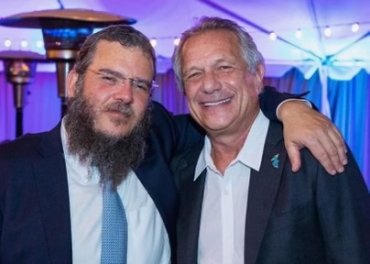Sara Braun: How A Born Black Jew Became Hasidic
Judaism is not simply a religion: We are a tribe, an ethnicity, an extended family, as well as a faith system. The misconception that Jews are only a religion or are all white continues to be pervasive, but there are more and more Jews speaking out about the complex nature of our identity. One of these voices is that of Sara Braun, who recently released a memoir, That Black Hasidic Lady: A Memoir of a Dark-Skinned Hasidic Woman.
Her childhood was one of little religion and recognition of her Jewishness, though she did know she was supposed to keep it quiet, due to antisemitism. She was born to a Jewish mother and non-Jewish father. She grew up in rural Holland, where she attended Montessori Dutch schools and had a very nature-based education. Only when she turned eighteen and left Holland did Sara have the opportunity to explore her Jewish roots, ultimately finding her home in the Hasidic community.
When asked about her family’s history of blackness, Sara explains that she, her mother, and grandmother all had dark skin, but her great-grandmother looked more like the “expected” Ashkenazi Eastern-European woman. In fact, because Sara’s grandmother was so comparatively dark-skinned to the rest of the family, she was put up for adoption and raised by a Black family, and later married a non-Jewish Black man. As the Jewish people originate in the Middle East, there are darker genes among all Jews, including Ashkanazi Jews, and they may come out differently in each child.
Sara acknowledges that her great-grandmother grew up in the early 1900s and in a society that cared deeply about color, but that did not, of course, excuse her racist behavior. Sara recounts that her sister Miriam’s first memory of their great-grandmother was being sung a racist lullaby.
Sara’s mother, Gita, was tragically orphaned at the age of five, and surprisingly, that same grandmother who had given up her child (Gita’s mother) for adoption, for being dark-skinned, took Gita in. Unfortunately, the environment was hostile, cold and racist, and Sara’s mother fostered negative feelings toward Judaism from a young age, associating the behavior with the religion.
When Gita’s grandmother found her dating a non-Jewish Black teenager, she sent her to live with an aunt in the Netherlands. Gita did ultimately marry a non-Jew despite this intervention, who was also a South American of mixed-race. “You can imagine what I am,” Sara jokes, regarding her family’s international history.
Sara’s journey from Holland to New York at 18 was a natural one, sparked by a teenager’s fascination with the city. Her journey from a nonreligious lifestyle to a Hasidic one was just as natural. Sara recounts how her innate curiosity about her Jewish roots — which had been kept off display her whole childhood in Holland due to the trauma associated with her great-grandmother — drove her through years of self-exploration as soon as she reached New York. “I know I have roots in Africa, I have roots in Asia, I have roots everywhere, but the spirit is a yiddishe spirit.” Sara became more and more religious over time, casually exploring different communities. It’s less about lifestyles than about communities, she explains. Even in Holland, there are some shuls where she feels more comfortable than others. It’s natural for some places to not be right for every person.
This yearning confused her mother, who had been traumatized by her Jewish grandparents; Gita found Sara’s move to Boro Park baffling, and the community she embraced to be hypocritical. Sara, meanwhile, finds that her reception in the Hasidic community as a Black woman has been predominantly positive. There will always be ignorant people who say distasteful things about her skin, or who will ask when she converted. Clearly, her own great-grandmother is a testament to the fact that religious Jews can participate in distasteful behavior. Sara, though, has found that that is not representative of the religion or community as a whole at all. Overall, she has felt accepted by both men and women in the Hasidic community.
As much as Sara herself finds prying questions and presumptions about her background annoying, she confesses that she also falls into this trap. When she doesn’t know the life story of a person of color who stands out in their community, she will never ask for their story directly, but she will always wonder. Unconscious and internalized bias exists everywhere, and it is up to us to be conscious of our thoughts and actions. We can always choose to be sensitive, and to watch our words.
Sara has experienced biases from the Black community as well. She spoke of a conversation she’d had with a first cousin on her grandfather’s side. She confessed that she did not speak the language that her grandfather grew up with in South America, and her cousin was astounded. She insisted that their grandparents always spoke with the grandkids in that language, then amended with, “Well, probably because [grandma] knows that you’re not…” Sara understood what went unsaid: she wasn’t like the rest of her cousins. By all accounts, Sara was predominantly perceived as a “child of her mother” in her father’s extended family as well for not being culturally “Black enough.”
In spite of social expectation, Sara does not consider herself a spokesperson for Jews to the Black community and vice versa. It is not the responsibility of people with blended cultural roots to be on display or act as mediators between their communities. Rather, Sara simply wishes and hopes for everyone to find happiness, health, and peace.
Although being considered the odd one out can be hurtful, Sara, if anything, is proud of her blended racial heritage. Out of curiosity, Sara took DNA tests together with her mother, and learned that her roots extend even further across the globe. While her mother didn’t particularly care about her genetic legacy, Sara was fascinated by the blend of peoples who made her who she is: a proud Jewish woman.
If you found this content meaningful and want to help further our mission through our Keter, Makom, and Tikun branches, please consider becoming a Change Maker today.







